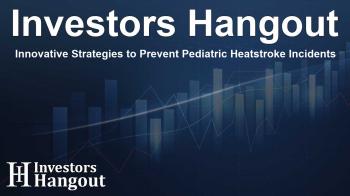Innovative Strategies to Prevent Pediatric Heatstroke Incidents

Innovative Strategies to Combat Pediatric Vehicular Heatstroke
A combination of interventions is essential to prevent tragic incidents of children dying in overheated vehicles.
Technological Advancements in Heatstroke Prevention
Pediatric vehicular heatstroke (PVH) has emerged as a significant concern, with various technologies being developed to aid caregivers. Researchers from Children's Hospital of Philadelphia (CHOP) have conducted a pivotal study identifying typical scenarios of PVH and the corresponding technologies designed to prevent these tragic events. Their findings emphasize that while some technology is effective, no single solution universally prevents all heatstroke cases, indicating the need for a multifaceted approach.
Analyzing Real World Scenarios
The research, published in the American Journal of Public Health, highlights a grim statistic: over 1,000 children have succumbed to PVH since 1998, with an average of 37 fatalities annually in the United States. The study systematically reviewed various case scenarios involving children who died in hot vehicles. Researchers categorized these cases to determine which technologies could potentially prevent such occurrences, emphasizing that more than one strategy should be employed.
Effective Technological Solutions
To tackle this issue effectively, several innovative technologies have been proposed. Some fall under 'indirect detection' methods, such as Bluetooth connections and GPS-enabled alerts, while 'direct detection' technologies involve pressure sensors that track breath and heartbeat. Additionally, alert systems that notify caregivers through sounds and secondary contacts have been developed. Researchers found that air conditioning left running can significantly reduce the risk of heatstroke, potentially preventing up to 80% of identified cases.
Collaboration with the Automotive Industry
Jalaj Maheshwari, a vital contributor to this study, stated, "No single technology could prevent all cases. However, a combination of efforts, including collaboration with the automotive sector, is crucial to enhancing safety." This partnership underscores a growing recognition within the automotive industry regarding the threat posed by PVH, which has begun to reflect in vehicle design and features.
Understanding the Risks
The identification of 10 specific scenarios among 354 recorded PVH incidents illustrates the varying effectiveness of each intervention. Detection technologies like carbon dioxide and radar can be successful in up to 90% of incidents, while other measures, like child seat sensors, showed less effectiveness.
Moreover, alert systems aimed at secondary contacts could facilitate appropriate intervention in all scenarios, provided the vehicle is accessible for immediate response. Despite these advances, the study also notes that its focus was solely on severe incidents, not addressing hundreds of near-misses that may still endanger children's lives.
Educational Initiatives for Caregivers
Kristy Arbogast, the senior study author, emphasized the importance of education for caregivers about the dangers posed by hot vehicles and the speed at which these circumstances can escalate. The study advocates for continued awareness campaigns alongside technological advancements. Dedicating efforts toward caregiver education, while supporting emerging technologies through partnerships with stakeholders, is essential to avert such avoidable tragedies.
Conclusion and Ongoing Research
This critical study, supported by the National Science Foundation's Center for Child Injury Prevention Studies at CHOP, aims to shed light on preventative strategies for pediatric vehicular heatstroke. The robust research underscores the significance of a collaborative effort between medical research organizations and the automotive industry, aiming to create a safer environment for children on our roads.
Frequently Asked Questions
What are the main findings of the study on pediatric vehicular heatstroke?
The study found that a mixture of technological interventions is necessary to prevent pediatric vehicular heatstroke effectively, as no single technology could address all scenarios.
How many children have died from pediatric vehicular heatstroke since 1998?
Over 1,000 children have tragically lost their lives to pediatric vehicular heatstroke, averaging 37 fatalities each year in the United States.
What technologies were discussed in the study?
The study explored various indirect and direct detection technologies, including pressure sensors, GPS-based alerts, and alerting systems that notify caregivers.
What role does the automotive industry play in preventing heatstroke?
The automotive industry is key in integrating safety technologies to combat pediatric heatstroke, acknowledging the urgency of this issue in vehicle design.
How can caregivers be educated on preventing vehicular heatstroke?
Ongoing awareness campaigns and educational programs about the dangers and prevention strategies for pediatric vehicular heatstroke are crucial for caregivers.
About The Author
Contact Kelly Martin privately here. Or send an email with ATTN: Kelly Martin as the subject to contact@investorshangout.com.
About Investors Hangout
Investors Hangout is a leading online stock forum for financial discussion and learning, offering a wide range of free tools and resources. It draws in traders of all levels, who exchange market knowledge, investigate trading tactics, and keep an eye on industry developments in real time. Featuring financial articles, stock message boards, quotes, charts, company profiles, and live news updates. Through cooperative learning and a wealth of informational resources, it helps users from novices creating their first portfolios to experts honing their techniques. Join Investors Hangout today: https://investorshangout.com/
The content of this article is based on factual, publicly available information and does not represent legal, financial, or investment advice. Investors Hangout does not offer financial advice, and the author is not a licensed financial advisor. Consult a qualified advisor before making any financial or investment decisions based on this article. This article should not be considered advice to purchase, sell, or hold any securities or other investments. If any of the material provided here is inaccurate, please contact us for corrections.

